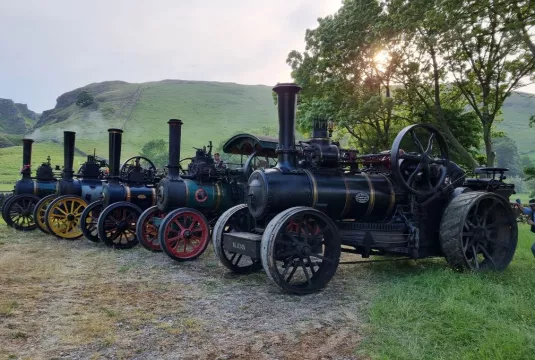Derbyshire's Steam Revolution: Pioneering the Industrial Age

In the heart of England, where rolling hills and lush landscapes meet innovation and industry, Derbyshire played a pivotal role in the Industrial Revolution. At the heart of this transformation was the revolutionary power of steam. Let's journey through time to explore how steam changed the course of history in Derbyshire, with a visit to local places of interest that showcase its significance.
1. The Steam Engine's Birthplace: Derbyshire is home to the historic market town of Chesterfield, known for its famous twisted spire. It was also the birthplace of Sir Richard Arkwright, a key figure in the Industrial Revolution. Arkwright's groundbreaking work in cotton spinning led to the creation of the water frame, a mechanized spinning frame powered by water wheels, a precursor to steam-powered machinery.
2. The Peak District: Nestled on the border of Derbyshire, the Peak District offers stunning natural beauty and hides a rich history within its hills. Quarrying and mining were integral to the region's economy, and steam engines powered these industries, revolutionizing production. The historic Magpie Mine near Bakewell is a testament to this era, featuring an old engine house powered by steam.
3. The Cromford Mill: A UNESCO World Heritage Site, the Cromford Mill stands as a testament to the impact of steam in Derbyshire. Built by Sir Richard Arkwright in 1771, this historic cotton mill was one of the world's first to be fully mechanized. Steam engines were utilized to drive the machinery, increasing productivity and setting a new standard for industrial efficiency.
4. The Butterley Company: Located in Ripley, the Butterley Company was a key player in the iron and engineering industries. Its Soho Foundry produced steam engines, railway locomotives, and ironwork during the 19th century, contributing to the development of transportation networks and boosting trade in Derbyshire and beyond.
5. The Derby Silk Mill: Often referred to as the "first factory in the world," the Derby Silk Mill was built in the early 18th century and played a pioneering role in the use of steam power. The mill used a steam engine to drive machinery and produce silk. Today, it stands as the Derby Museum and Art Gallery, showcasing the region's industrial history.
6. The Derby and Sandiacre Canal: Built in the late 18th century, the Derby and Sandiacre Canal was vital for transporting goods in and out of Derbyshire. Steam-powered engines pulled canal barges, contributing to the region's economic growth. The remnants of this canal system can still be explored today, providing a glimpse into its significant role.
7. The Midland Railway Centre: Located in Ripley, the Midland Railway Centre preserves the legacy of steam locomotion in Derbyshire. Visitors can experience the magic of steam travel on historic railway lines, offering a firsthand look at how steam revolutionized transportation and trade.